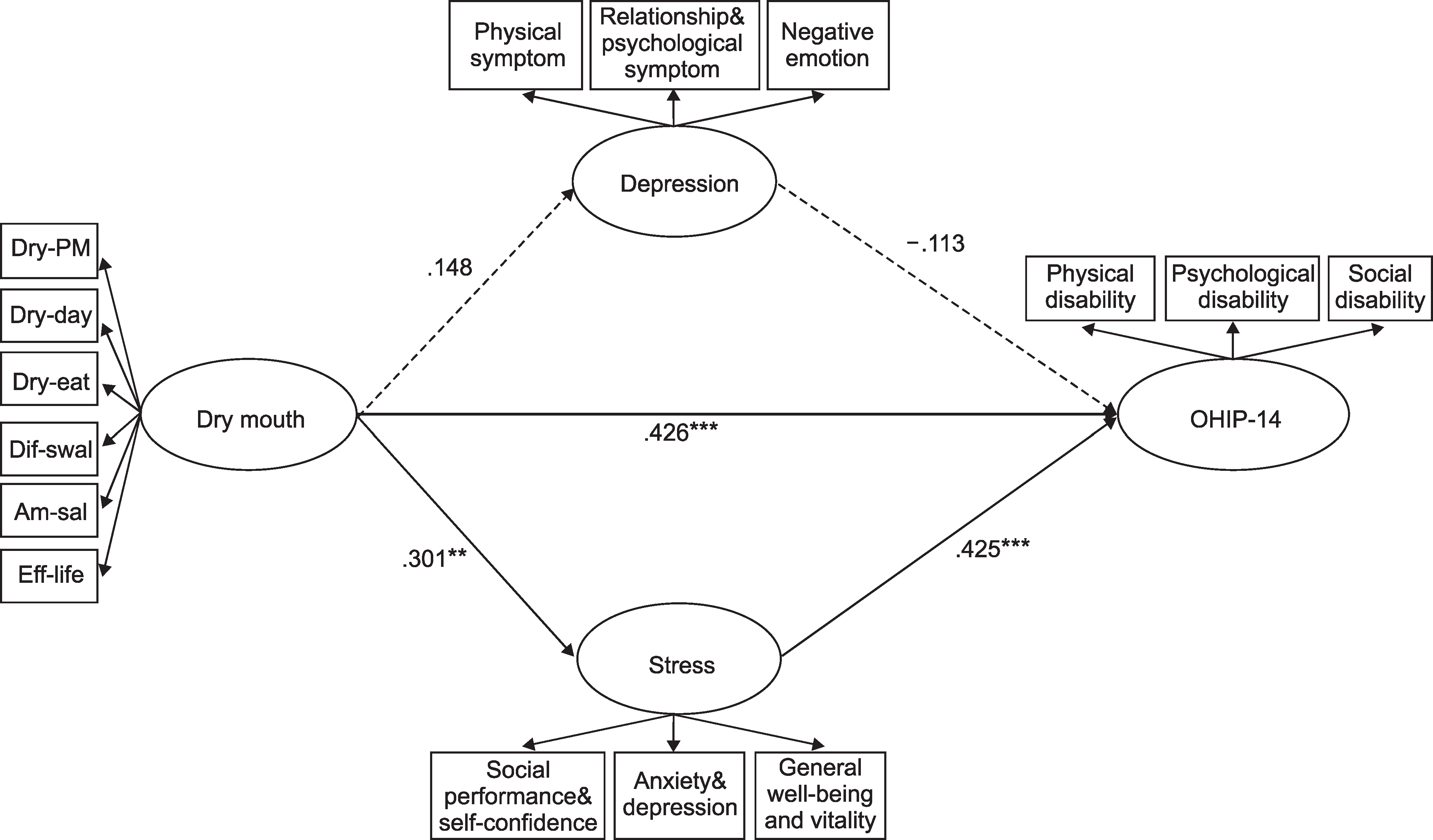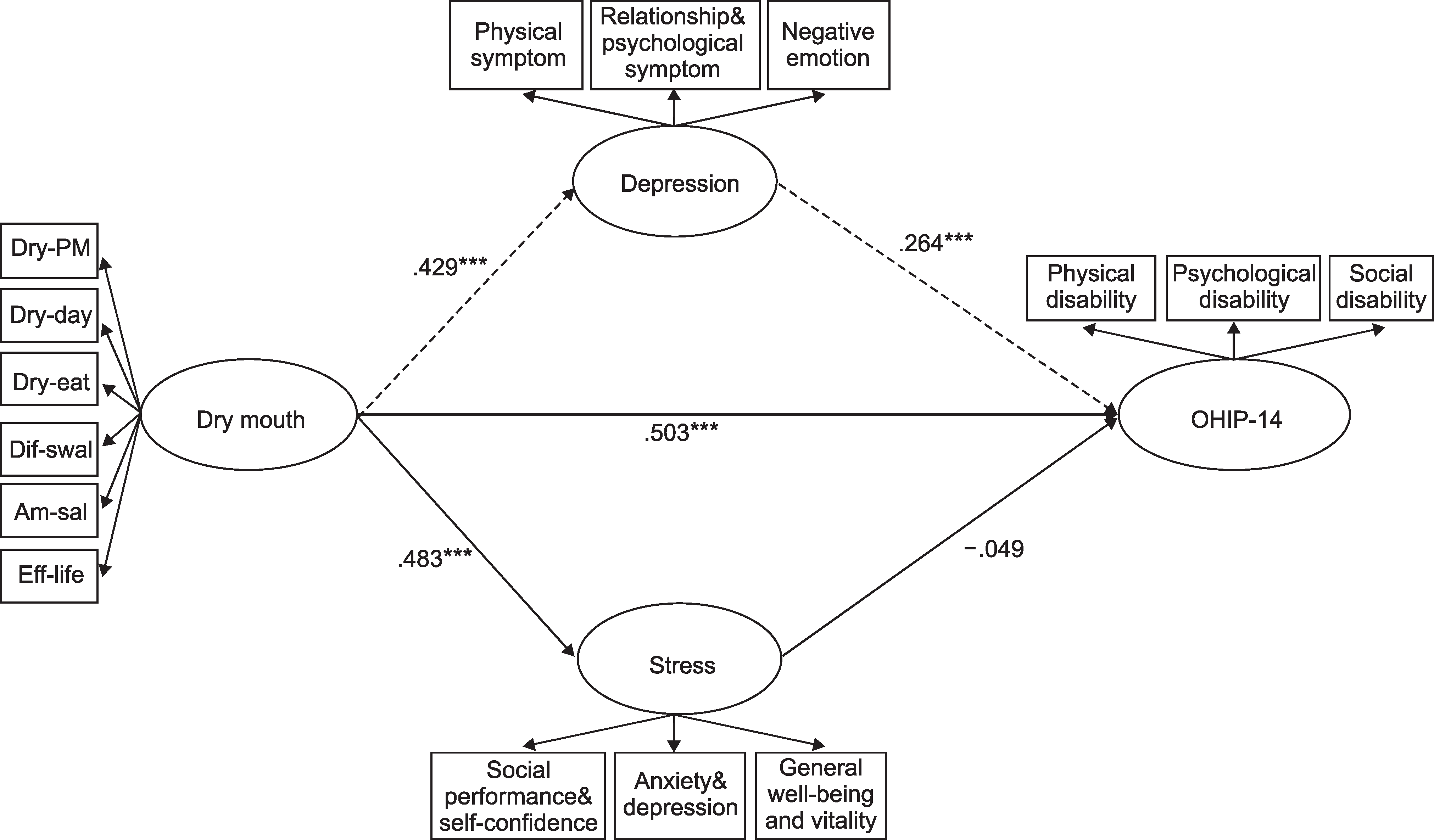Abstract
Objectives
The aim of this study was to investigate the role of psychological factors as mediators in the casual relationship between mouth dryness and oral health-related quality of life of adults and to explore gender differences in what psychological factors play an important role in mediating the path of mouth dryness to quality of life.
Methods
Self-administered questionnaires were distributed to 321 adults who are above 20 and under 65 years of age. Collected data were analyzed via statistical packages using a multi-group analysis through the SEM (Structural Equation Model).
Results
Based on the statistical analysis, stress was a major psychological factor in male subjects. While depression served as a main mediator in female subjects. We discovered that the path coefficients of the following paths showed significant gender differences: mouth dryness → depression, depression → quality of life, stress → quality of life.
Go to : 
References
1. von Knorring L, Mornstad H. Qualitative changes in saliva composition after short-term administration of imipramine and zime-lidine in healthy volunteers. Scand J Dent Res. 1981; 89:313–320.
2. Napenas JJ, Brennan MT, Fox PC. Diagnosis and treatment of xerostomia (dry mouth). Odontology. 2009; 97:76–83.

3. Thomson WM, Lawrence HP, Broadbent JM, Poulton R. The impact of xerostomia on oral-health-related quality of life among younger adults. Health Qual Life Outcomes. 2006; 86:1–7.

4. Nederfors T, Isaksson R, Mörnstad H, Dahlöf C. Prevalence of perceived symptoms of dry mouth in an adult Swedish population relation to age, sex and pharmacotherapy. Community Dent Oral Epidemiol. 1997; 25:211–216.
5. So JS, Chung SC, Kho HS, Kim YK, Chung JW. Dry mouth among the elderly in Korea: a survey of prevalence, severity, and associated factors. Oral Surg Oral Med Oral Pathol Oral Radiol Endod. 2010; 110:475–483.

6. Al-Hashimi I. Xerostomia secondary to Sjögren’s syndrome in the elderly: recognition and management. Drugs Aging. 2005; 22:887–899.
7. Guggenheimer J, Moore PA. Xerostomia: etiology, recognition and treatment. J Am Dent Assoc. 2003; 134:61–69.
8. Matear DW, Locker D, Stephens M, Lawrence HP. Associations between xerostomia and health status indicators in the elderly. J R Soc Promot Health. 2006; 126:79–85.

9. Villa A, Abati S. Risk factors and symptoms associated with xerostomia: a cross-sectional study. Aust Dent J. 2011; 56:290–295.

10. Anttila SS, Knuuttila ML, Sakki TK. Depressive symptoms as an underlying factor of the sensation of dry mouth. Psychosom Med. 1998; 60:215–218.

11. Gerdin EW, Einarson S, Jonsson M, Aronsson K, Johansson I. Impact of dry mouth conditions on oral health related quality of life in older people. Gerodontol. 2005; 22:219–226.
12. Park ES, Choi JS. The associated factors with whole saliva flow rate and xerostomia. J Dent Hyg Sci. 2012; 12:171–179.
13. Park HJ, Shim YS, Lee JH, Sohn MS. The structural relations between health-related behaviors, subjective health status, and self-rated stress: focusing on mediated role of oral dryness. Int J Dig Cont Tech Appl. 2013; 13:393–399.
14. Hong MH. The influence of stress on oral mucosal disease, dry mouth and stress symptoms in adults. J Korean Soc Dent Hyg. 2013; 13:589–596.

15. Kim RB, Park KS, Lee JH, Kim BJ, Chun JH. Factors related to depression Symptoms and the influence of depression symptoms on self-rated health status, outpatient health service utilization and quality of life. Korean J Health Educ Promot. 2011; 28:81–92.
16. Sohn AR Kim TK, Ryu EJ, Oh GJ, Ahn DH. Mental health and stress by socio-demographic characteristics among seoul citizens. Korean J Health Educ Promot. 2010; 27:71–80.
17. Billings RJ, Proskin HM, Moss ME. Xerostomia and associated factors in a community-dwelling adult population. Community Dent Oral Epidemiol. 1996; 24:312–316.

18. Lee JY, Lee YO, Kho HS. Reliability of a questionnaire for evaluation of dry mouth symptoms. J Korean Acad Oral Med. 2005; 30:383–389.
19. Slade GD. Derivation and validation of a short-form oral health impact profile. Community Dent Oral Epidemiol. 1997; 25:284–290.

20. Roberts RE, Vernon SW. The center for epidemiologic studies depression scale: its use in a community sample. The American J Psychiatry. 1983; 140:41–46.
21. Bagozzi RP, Yi Y. On the evaluation of structural equation models. J Acad Mark Sci. 1998; 16:74–94.

22. Turner MD, Ship JA. Dry mouth and its effects on the oral health of elderly people. J Am Dent Assoc. 2007; 138:15S–20S.

23. Thomson WM. Issues in the epidemiological investigation of dry mouth. Gerodontol. 2005; 22:65–76.

24. Park MS, Ryu SA. Degree of dry mouth and factors influencing oral health-related quality of life for community-dwelling elders. J Korean Acad Nurs. 2010; 40:747–755.

25. Lee MR, Han GS, Han SJ, Choi JS. Impact of subjectively reported oral health status on the quality of life among adults: applying the PRECEDE model. Korean J Health Educ Promot. 2011; 28:23–35.
26. Kline RB. Principles and practice of structural equation modeling. 2nd ed. New York: The Guildford Press;2005.
27. Hong MH. The effects of occupational stress on oral health impact profile (OHIP) in local government workers. J Korean Soc Dent Hyg. 2012; 12:471–483.

28. Jang JH, Kim SH. The relationship between xerostomia and depression in elderly people. Korean J Health Educ Promot. 2007; 24:51–60.
29. Baker SR. Pankhurst CL, Robinson PG. Utility of two oral health related quality of life measures in patients with xerostomia. Community Dent Oral Epidemiol. 2006; 34:351–362.
Go to : 
 | Fig. 1.Structural model based on estimation of standardized path coefficients in male. *P<0.05, **P<0.01, ***P<0.001. †Solid lines=significant direct effect, Dashed line=no significant direct effect. ‡OHIP-14, Oral Health Impact Profile. |
 | Fig. 2.Structural model based on estimation of standardized path coefficients in female. *P<0.05, **P<0.01, ***P<0.001. †Solid lines=significant direct effect, Dashed line=no significant direct effect. ‡OHIP-14, Oral Health Impact Profile. |
Table 1.
Descriptive statistics of variables by gender (N=321)
Table 2.
Means, standard deviations (SD), and ranges for study model variables
| Variables | Mean | SD | Range |
|---|---|---|---|
| Mouth dryness | 19.44 | 10.87 | 6-66 |
| Depression | 32.93 | 8.79 | 23-77 |
| Stress | 53.34 | 5.26 | 18-71 |
| OHIP-14 | 24.44 | 8.50 | 14-61 |
Table 3.
Evaluation of the overall fit of model
| Fit indices | χ 2 | df | P-value | GFI | TLI | CFI | RMSEA |
|---|---|---|---|---|---|---|---|
| Value | 332.341 | 79 | 0.000 | 0.897 | 0.912 | 0.933 | 0.090 |
| Recommended value | 0.05 | ≥0.9 | ≥0.9 | ≥0.9 | ≤0.08 |
Table 4.
Indirect effect of the model
| Paths | Male | Female | ||
|---|---|---|---|---|
| Indirect effect | P-value | Indirect effect | P-value | |
| Mouth dryness → Depression → OHIP-14 | - | - | 0.101 | 0.035 |
| Mouth dryness → Stress → OHIP-14 | .111 | 0.016 | - | - |
Table 5.
Mediator effect of the model
| Paths | Male | Female | ||
|---|---|---|---|---|
| Z | P-value | Z | P-value | |
| Mouth dryness → Depression → OHIP-14 | - | - | 3.016 | 0.003 |
| Mouth dryness → Stress → OHIP-14 | 3.150 | 0.002 | - | - |
Table 6.
Measurement invariance of unconstrained and constrained models
| Fit indices | Model fit | ||||
|---|---|---|---|---|---|
| χ 2 | df | P-value | CFI | RMSEA | |
| Unconstrained | 418.752 | 132 | 0.000 | 0.914 | 0.083 |
| Measurement weights | 426.055 | 142 | 0.000 | 0.915 | 0.079 |
| Recommended value | P<0.05 | ≥.90 | ≤.08 | ||
Table 7.
Gender difference in multi-group analysis of various paths
| Path Constrained | β | χ 2 | df | ∆χ 2/df | |
|---|---|---|---|---|---|
| Unconstrained Model | Male | Female | 418.752 | 132 | |
| Mouth dryness OHIP-14 → | 0.426 | 0.503 | 419.152 | 133 | 0.400 |
| Mouth dryness Depression → | 0.148 | 0.492 | 423.473 | 133 | 4.721* |
| Mouth dryness OHIP-14 → | ―0.113 | 0.264 | 424.602 | 133 | 5.850* |
| Mouth dryness Stress → | 0.301 | 0.483 | 418.818 | 133 | 0.066 |
| Mouth dryness OHIP-14 → | 0.425 | ―0.049 | 427.393 | 133 | 8.641* |




 PDF
PDF ePub
ePub Citation
Citation Print
Print


 XML Download
XML Download